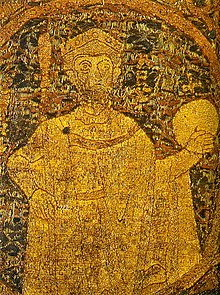Stephen I of Hungary
| Saint Stephen I | |
|---|---|
| King of the Hungarians, King of the Pannonians or King of Hungary | |

Portrayal of Stephen I on the Hungarian coronation pall from 1031
|
|
| King of Hungary | |
| Reign | 1000 or 1001–1038 |
| Coronation | 25 December 1000 or 1 January 1001 |
| Predecessor | Himself as Grand Prince |
| Successor | Peter |
| Grand Prince of the Hungarians | |
| Reign | 997–1000 or 1001 |
| Predecessor | Géza |
| Successor | Himself as King of Hungary |
| Born |
c. 975 Esztergom, Principality of Hungary |
| Died | 15 August 1038 (aged 62–63) Esztergom or Székesfehérvár, Kingdom of Hungary |
| Burial | Székesfehérvár Basilica, Székesfehérvár, Hungary |
| Spouse | Gisela of Bavaria |
| Issue | Otto Saint Emeric |
| Dynasty | Árpád dynasty |
| Father | Géza of Hungary |
| Mother | Sarolt |
| Religion | pre-Schism Catholic |
| Signature |  |
| King Saint Stephen | |
|---|---|
 |
|
| King and Confessor | |
| Born |
c. 975 Esztergom, Hungary |
| Died | 15 August 1038 Székesfehérvár, Hungary |
| Venerated in |
Roman Catholic Church Eastern Orthodox Church |
| Canonized | 20 August 1083, Székesfehérvár by Pope Gregory VII |
| Major shrine |
St. Stephen's Basilica Budapest, Hungary |
| Feast | 16 August 20 August (in Hungary) 30 May (his Holy Dexter in Hungary) |
| Attributes | Crown; Sceptre; globe |
| Patronage | Patron saint of Hungary Patron of kings, masons, stonecutters, stonemasons and bricklayers Protector against child death |
Stephen I, also known as King Saint Stephen (Hungarian: Szent István király; Latin: Sanctus Stephanus; Slovak: Štefan I. or Štefan Veľký; c. 975 – 15 August 1038 AD), was the last Grand Prince of the Hungarians between 997 and 1000 or 1001, and the first King of Hungary from 1000 or 1001 until his death in 1038. The year of his birth is uncertain, but many details of his life suggest that he was born in or after 975 in Esztergom. At his birth, he was given the pagan name Vajk. The date of his baptism is unknown. He was the only son of Grand Prince Géza and his wife, Sarolt, who was descended from the prominent family of the gyulas. Although both of his parents were baptized, Stephen was the first member of his family to become a devout Christian. He married Gisela of Bavaria, a scion of the imperial Ottonian dynasty.
After succeeding his father in 997, Stephen had to fight for the throne against his relative, Koppány, who was supported by large numbers of pagan warriors. He defeated Koppány mainly with the assistance of foreign knights, including Vecelin, Hont and Pázmány, but also with help from native lords. He was crowned on 25 December 1000 or 1 January 1001 with a crown sent by Pope Sylvester II. In a series of wars against semi-independent tribes and chieftains—including the Black Hungarians and his uncle, Gyula the Younger—he unified the Carpathian Basin. He protected the independence of his kingdom by forcing the invading troops of Conrad II, Holy Roman Emperor, to withdraw from Hungary in 1030.
...
Wikipedia
